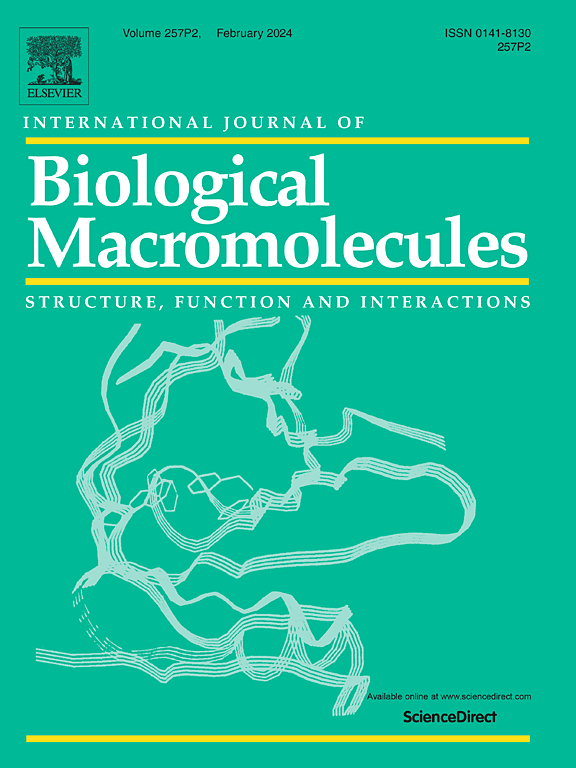聚乙烯接枝纤维素去除废水中邻苯二甲酸二乙酯的制备
IF 8.5
1区 化学
Q1 BIOCHEMISTRY & MOLECULAR BIOLOGY
International Journal of Biological Macromolecules
Pub Date : 2025-06-01
DOI:10.1016/j.ijbiomac.2025.144717
引用次数: 0
摘要
以木屑为原料制备了一种新型聚乙二醇功能化纤维素吸附剂,用于废水中邻苯二甲酸二乙酯(DEP)的高效脱除。该合成过程包括:木屑连续酸(0.1 M HCl)和碱(0.1 M NaOH)水解,然后氯酸钠漂白和PEG接枝在纤维素基体上引入亲水性乙二醇基团。在初始DEP浓度(100 mg/L)、吸附剂剂量(0.6 g/L)、接触时间(60 min)和pH(7)条件下,PEG-Cell吸附剂表现出优异的DEP去除性能,去除效率为97.5%,吸附量为512.46 mg/g。平衡研究表明,吸附过程遵循Langmuir等温线模型,表明DEP分子与PEG-Cell功能化表面之间存在单层覆盖和强化学相互作用。动力学研究表明,吸附符合准二级吸附模型,证实了化学吸附是主要吸附机理。热力学研究进一步支持了该过程的可行性,负ΔG°值(−8.3 kJ/mol)表明该过程是自发的,而正ΔH°(45.3 kJ/mol)和ΔS°(0.18 kJ/mol·K)表明该过程是吸热和熵驱动的过程。该吸附剂表现出优异的可重复使用性,在多次再生循环中保持高效率(>90%),容量损失最小。这些发现强调了PEG-Cell作为一种经济、可持续、高效的吸附剂,可从受污染的水源中去除DEP和其他邻苯二甲酸盐,为可扩展的废水处理应用提供了巨大的潜力。本文章由计算机程序翻译,如有差异,请以英文原文为准。
Preparation of polyethylene grafted cellulose for the removal of diethyl phthalate from wastewater
A novel polyethylene glycol (PEG)-functionalized cellulose adsorbent (PEG-Cell) derived from sawdust was developed for the efficient removal of diethyl phthalate (DEP) from wastewater. The synthesis involved sequential acid (0.1 M HCl) and alkaline (0.1 M NaOH) hydrolysis of sawdust, followed by sodium chlorate bleaching and PEG grafting to introduce hydrophilic glycol groups onto the cellulose matrix. The PEG-Cell adsorbent demonstrated exceptional DEP removal performance at optimized conditions: initial DEP concentration (100 mg/L), adsorbent dose (0.6 g/L), contact time (60 min), and pH (7) achieving 97.5% removal efficiency and a remarkable adsorption capacity of 512.46 mg/g. Equilibrium studies revealed that the adsorption process followed the Langmuir isotherm model, suggesting monolayer coverage and strong chemical interactions between DEP molecules and PEG-Cell’s functionalized surface. Kinetic study indicated that the adsorption adhered to the pseudo-second-order model, confirming chemisorption as the dominant mechanism. Thermodynamic investigations further supported the process’s feasibility, with negative ΔG° values (−8.3 kJ/mol) indicating spontaneity, while positive ΔH° (45.3 kJ/mol) and ΔS° (0.18 kJ/mol·K) values suggested an endothermic and entropy-driven process. The adsorbent exhibited excellent reusability, maintaining high efficiency (>90%) over multiple regeneration cycles with minimal capacity loss. These findings highlight PEG-Cell as a cost-effective, sustainable, and highly efficient adsorbent for removing DEP and other phthalates from contaminated water sources, offering significant potential for scalable wastewater treatment applications.
求助全文
通过发布文献求助,成功后即可免费获取论文全文。
去求助
来源期刊
CiteScore
13.70
自引率
9.80%
发文量
2728
审稿时长
64 days
期刊介绍:
The International Journal of Biological Macromolecules is a well-established international journal dedicated to research on the chemical and biological aspects of natural macromolecules. Focusing on proteins, macromolecular carbohydrates, glycoproteins, proteoglycans, lignins, biological poly-acids, and nucleic acids, the journal presents the latest findings in molecular structure, properties, biological activities, interactions, modifications, and functional properties. Papers must offer new and novel insights, encompassing related model systems, structural conformational studies, theoretical developments, and analytical techniques. Each paper is required to primarily focus on at least one named biological macromolecule, reflected in the title, abstract, and text.

 求助内容:
求助内容: 应助结果提醒方式:
应助结果提醒方式:


